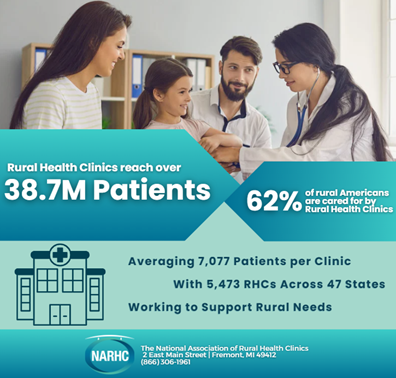Survey Emphasizes Scale and Significance of the RHC Program
RHCs Provide Services for Over 62% of Rural America
Vencetia Flournoy
According to a 2024 Policy Survey conducted by the National Association of Rural Health Clinics (NARHC), Rural Health Clinics (RHCs) serve over 62% of rural Americans.
“We are deeply appreciative of the responsiveness from RHCs across the country” said Sarah Hohman, NARHC’s Director of Government Affairs. “Their feedback and data are critical to the future of NARHC and the RHC program as we work to understand and represent the experiences and priorities of the 5,400+ RHCs.”
The 2024 data show that the average RHC serves 7,077 patients, a figure which substantiates last year’s result (7,150 patient per RHC). Calculated across 5,473 RHCs nationwide, this data suggests that RHCs provide care for about 38.7 million Americans which means that RHCs serve well over half of all Americans living in rural communities.

The survey also sought to better understand RHC attitudes surrounding telehealth and care management. About 75% of RHCs reported utilizing telehealth for either mental or medical services, and over 69% reported that they plan to maintain or expand their care management services in the coming future.
However, with telehealth and care management comes implementation challenges, especially for rural providers. NARHC asked for comments regarding challenges RHCs have faced with telehealth and care management. The most common limitations to telehealth and care management cited were staffing shortages, connectivity issues, concerns about reimbursement security, and a lack of patient engagement.
The survey also sought to better understand the impact of Medicare Advantage (MA) growth on RHCs. While 31% of respondents indicated that MA plans reimbursed their RHCs roughly the same as traditional Medicare, 48% of RHCs respondents indicated that MA reimbursed them slightly (18.4%) or significantly (29.5%) less than traditional Medicare.
“As Medicare Advantage grows, we are increasingly concerned about the financial strain this growth will put on our rural health clinics,” said Nathan Baugh, NARHC’s Executive Director. “While we are happy to see that some RHCs are still able to negotiate rates comparable to their traditional Medicare All-Inclusive Rate (AIR), we are disheartened to see that almost half of our respondents are receiving less than their costs from MA plans. If current trends continue, MA will start putting rural providers out of business.”
While the survey shows that payer mix varies widely RHC to RHC, government payers represent on average 64% of RHC patient volume. Payer mix data amongst respondents showed that an average RHC sees approximately 30% Medicaid/CHIP, 22% traditional Medicare, and 12% Medicare Advantage. 31% of patients are commercially insured and about 6% of patients are uninsured.
The full survey results are available here.
Please contact Sarah Hohman, NARHC Director of Government Affairs at Sarah.Hohman@narhc.org with any questions regarding the RHC program or the 2024 survey results.

